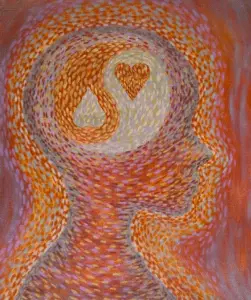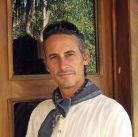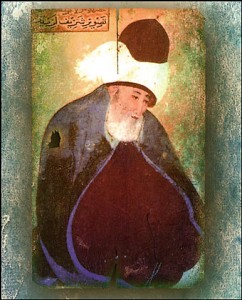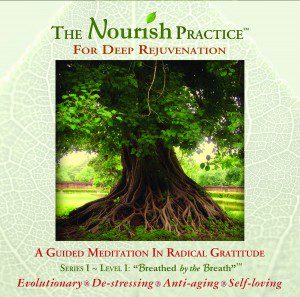Contributing Writer for Wake Up World
This article will appear in several parts.
Paradox is a beautiful thing. As a signpost on the road to integration, paradox signals homecoming to wholeheartedness. Paradox is more circular than it is linear; it is the fork in the road whose seemingly divergent paths are joined all along. Paradox is to travel both those curves simultaneously—one overt and one hidden—ever-arriving in the true shape of our large, non-dual hearts.
Paradox is also represented in another of my favorite circular symbols for wholeness via transformation, the ouroboros. The ouroboros bites its tail to symbolize inclusion of everything in between head and end, endings and beginnings, now and then as eternity, along life’s sinuous body we help bend into the circle of good life as the endeavor of compassionate human growth. Paradox itself is an existential model for wholeness because it unites apparent opposites. It embraces dark and light, positive and negative, material and immaterial, body and mind. The courageous trick is to grow through both polarities of paradox to experience its rich fullness.
[pro_ad_display_adzone id=”110028″]
Ontological paradox is to live into one thing to experience its apparent opposite. Paradox is what leads to results that we did not expect while pursuing the apparent antithesis of those results. While paradox is commonly considered a form of contradiction, through the lens of integral living it bears more elegance and artfulness than contradiction. If we can embrace the fullness of paradox we have come a long way towards appreciating reality and living a deep, meaningful life.
What does paradox look like in real life, and how does it apply generally to spirituality? Consider the popular spiritual goals of “oneness” or “yogic union,” for example. If we try to merge with the external world in a literal sense, as an overt effort towards oneness, we may make more connections and friends and serve our community in logistical ways. While this can be meaningful and we may have some profound experiences doing so, I consider literally pursued oneness a generally superficial experience of “union.” It is superficial in part because we are pursuing a multi-tiered, complex, holistic enterprise primarily only linearly, objectively, and literally—we pursue this spiritual goal per our idea of it. If, on the other hand, we experience the world and our place in it via paradoxical means, we can experience ourselves both more superficially and profoundly, individually whole and collectively untied, both poetically and literally.
Let’s look into another aspect of paradoxical spirituality. An “open heart” is considered a poetic metaphor for love and inclusion, and a portal to the experiences of “union” and “oneness.” If we focus our attention inwardly to the places in our hearts (our whole body-minds) that are hurt and blocked, this narrow entry into emotional pain would seem to be the opposite of the feel-good, expansive experience literally understood as oneness or universal love. Yet if we understand that in order to fully open, our hearts actually have to break open to the places we would otherwise not choose to go on a sunny day, we can better appreciate and courageously celebrate our most challenging moments and live inside paradox.
Breaking down allows us to rise in love. One of Leonard Cohen’s great lines goes something like, “There are many paths to enlightenment, but each begins with a broken heart.” When we can embrace our emotional hurts, we get the opportunity to break open, which should be our greatest wish in life! This way we can unwind the tense and knotted, the paralyzed and undernourished, emotional conflicts deep in our bodies, and this way heal them, making more of us available to experience joy and oneness.
One of poetry’s beauties is that it can convey ontological, experiential truth in ways not as easily conveyed (or at all) in ordinary language. Poetry is a first-rate delivery system for conveying how to live paradoxically, more fully. But poetry also helps us live more logically and linearly, more realistically and literally, when we understand the meaning and utility of its hints and images. Check out this first part of Rumi’s poem that speaks to the art of paradox.
The moment you accept what troubles you’ve been given,
the door will open.
Welcome difficulty as a familiar comrade.
Joke with torment brought by the Friend.
Sorrows are the rags of old clothes and jackets
that serve to cover, then are taken off.
That undressing,
and the naked body underneath,
is the sweetness that comes after grief.
The hurt you embrace becomes joy.
Call it to you where it can change. ” ~ Rumi
Rumi refers to alchemy as the process of transforming pain into pleasure, which he later will support in the next section of this poem, with allusions to the silkworm and emerging butterfly. Troubles are usually considered roadblocks, but paradoxically, Rumi tells us they are portals. Heartfelt transformation activates our innate capacity to turn life’s lemons into lemonade, or more accurately, into lemon trees! Notice at the end of this piece Rumi says, “Call it to you where it can change.” Although I think it richer to say, “Call it to you so it can change you,” this is Rumi’s call for us to be courageous so that we can we can transform our hurts into joy, and increase our very capacity for wholehearted love.
Illness, loss, disappointment, and tragedy are part of life. Rather than reject them as interferences and obstacles to a full life, when we can include and accept them, in all the gritty and messy ways they twist, turn and provoke us, we include the ostracized and stigmatized aspects of life into what we consider life. We live beyond our ideas of happiness, beyond the comfort of denying life’s perpetual edges into a felt experience of richness and wholeness. When we reject necessary calls to courage, life turns out to be not so comfortable after all, ironically enough. If we cannot dive into paradox, we can at least approach the frontier of transformation by noticing where our linear ideas of spiritually actually numb and restrict our entry into passionate living.
Nobody really likes emotional pain; we are hardwired not to. Yet, we are mysteriously also wired to be able to transcend pain via accepting and transforming it. This happens via a surprising process called neuroplasticity, explored more in the sequel to this article. While feeling pain’s truth we can also open our hearts and summon other uniquely human capacities such as imagination, compassion, and self-reflection to turn pain’s sourness into lemonade and lemon trees—into “the sweetness that comes after grief.” In fact, embracing life’s failing sides (Yin) opens and activates (Yang) our hearts in ways and to depths that linear pleasure and joy cannot. This is how Yin practically enhances Yang in everyday life.
What we really need then is courage and wisdom, patience and perseverance, to develop a more malleable, accepting heart, a more inclusive appreciation for life’s lowlights, which grounds, humanizes, and humbles our spirituality.
Within our pains are the bound-up resources to experience life with more meaning, passion, exuberance, love, depth, compassion, and gratitude. We arrive wholeheartedly into the underbelly, the ground, of these cherished qualities paradoxically, by going into what we think they are not—the alchemical grist of Rumi’s poetry mill.
The eventual exhilaration, the palpable experience of inner freedom, the unmistakable feeling of joining something larger than ourselves by going into what seems to be the opposite of union, freedom, and love is the exquisite beauty of paradox and living poetically. But we must call difficult opposites to us, not so much by inviting trouble, drama, and pain, but by finding these already-buried aches in our bodies, our own hearts. Then we must devote at least as much time to befriending grief, remorse, shame, and fear as we do the easier, positive, linear, and literal aspects of spirituality so that we can allow these latter, cherished and positive qualities to find us, to change us. This is radical, realistic, all-inclusive spiritual surrender.
What prevents us from feeling united with life, one another, and being able to consistently abide in our hearts and “welcome difficulty as a comrade” is our fear of feeling badly. Again, we are hard-wired to avoid emotional pain, which the more primitive aspects of our brain and nervous system confuse with literal death. Additionally, we can fear a current situation as well as what emotional memories the present triggers in us. After considering integral spirituality poetically, artfully ontologically, let’s see if we can find some of these correlations through the lens of science and new discoveries about our brains and nervous systems.
 Emotional Memory as a Treasure Map to Wholeness
Emotional Memory as a Treasure Map to Wholeness
Understanding the neurobiology of our nervous systems supports our subjective experience that current situations can activate past, often unconscious, memories. This is called “emotional memory.” Emotional memories “laid down” as neural connections (which convey and store information) from past experience become linked with similar experiences and relate to similar regions of our brains, our bodies in general, and our actual hearts. Our hearts are now known to have many neural connections with our brains, with the majority of the information traffic directed from our hearts to our brains, not vice-versa. This discovery helps corroborate the Eastern philosophical and holistic medical reality of “heart-mind,” as the unity of hearts and heads. It explains the interdependent aspects of our emotional and thinking selves.
Fearful emotional memory can be activated when, for example, we feel automatically defensive in the face of criticism, or unduly upset about a disappointment, or misinterpret someone’s actions or words. Only we can know if we are “overreacting” in the present because of a past hurt, and it behooves us to be honest with ourselves if this is the case. It may seem easier to avoid dipping into ourselves to do some emotional work from the past in light of a current situation, but this option is ultimately really only more difficult and, ironically, creates more suffering. In other words, we lose out when we think or defend against being emotionally honest. This is an example of how avoiding paradox lands us squarely in the midst of living out the dark side of its irony—the other end of the ouroboros’ tail we deny and do not welcome the taste of in our mouths, or deeper to digest. We hereby convert its otherwise helpful tail into a lethal and venomous head that returns again and again to bite us from behind…until we can rest with its sharpness in the softness of our insides.
Fearful memory can also be triggered at a more fundamentally physical level when a given situation reminds us of a past trauma. For example, as a child I was hit by a car on my bicycle while crossing an alley. I was thrown from my bike, bloodied and bruised. For years after, whenever I would approach an alley, hear of an alley, or see an alley, I would experience some degree of pain and apprehension. These feelings are elicited in my physiology to protect me, to help me survive, which is why evolution has hardwired such emotional memories into my psyche, and yours. The complex mix of emotions and memories releases an equally complex cascade of hormones, neurotransmitters, and other chemical reactions that I experience as more emotions, memories, and physical sensations.
A fear of alleys, like a fear of getting our hearts broken, creates aversion. It teaches us boundaries and practical cautions, plunges us into the seemingly messy and conflicting arena of logic versus emotion. Yet, when we can breathe deeply, be patient and mindful, accept our hurts, understand their lessons, and unwind their heart-mind contractions in our bodies in a safe, reasonable way we can experience the cooperation of logic and emotion, uniting Yin and Yang, the head and the tail of the ouroboros of our psyches.
When approaching an alley, logic tells me that I don’t need to fear every alley as a life-threatening situation and that the odds of being hit again are slim, especially if I am careful. Emotion informs me “here is danger,” and the cascade of more fearful thoughts and neurochemistry follow. Being with, gently breathing into, accepting my fear, yet using reason to allow me to continue riding my bike and carefully cross alleys helps me live more easily and productively.
Even though more emotionally based traumas—such as a broken heart and enduring losing a loved one—that do not primarily impact us physically, like a bike accident, they correspond with similar physical memory associations, neurochemical cascades, and inter-neural communication. Their healing—via unwinding the physical-mental-emotional complexes known as memories and associated feelings—commensurately requires the same whole-body centered, emotional and mental healing processes. Overcoming my fear of alleys and injury becomes a physical and emotional process, not just a tough or reasonable logical one of “getting over my fear.” Fear is not an obstacle to spiritual growth and love. When sensitively and intelligently appreciated, fear instead becomes an ally for moderating recovery from trauma, a spiritual braking system for my heart, so that it can proceed safely, wisely, cautiously forward. Many people think fear is the opposite of love because they never bother to accept it, learn with it, think critically about fear, hold it in their mouths, in their hearts long enough to be informed and transformed by it.
Far from labeling fear as unilaterally “bad,” as New-Age spirituality does, my fear of alleys and injury can actually bolster my spirituality by warning me of danger so to protect my life, make me more humble, as well as bring me closer to the reality of death and illness, which is always spiritually enriching. Embracing fear for its fruits gifts me paradoxical immunity from foolish, linear, one-sided belief systems and ideas about the constant need to devalue and dismiss fear and sane limitations.
To recap, when we are intimate and patient, sensitive and honest, to the sensations in our bodies (generated neurobiologically), we can “lean and learn” into our emotional memories—those activated by current situations that become neurally associated with significant, similar past events. This process actually happens in us, at lightning speed, invisible to our material inspection, yet apparent to our awareness when we are present to notice. Trauma and ordinary heartache creates physical-emotional changes in us on a microscopic level, which must be unwound physically-energetically-emotionally at the same level of our physiology. When our physical-emotional wounds go unresolved, the degree to which we do not take responsibility for our spiritual health and “own our own stuff,” is the degree to which we project our own wounds and injure our most valued relationships.
Those currently closest to us are the only ones who can so easily, deeply, and comprehensively trigger our most core and foundational (childhood) love experiences—and our most powerful enjoyable and difficult emotions—as recorded in our nervous systems via emotional memory. So, not only do such painful events hurt in the present moment, but they can be exaggerated when they activate existing neural pathways that “remember” how we were criticized or disavowed once ago. In essence, what is past becomes present in us when the present reminds us, usually unconsciously, of the past. The upshot: fear is not realistically so easily discarded—nor should it be—and comprehensive healing of our hearts is not nearly as simple as thinking positively and “moving on.”
Appreciating the reality of emotional memory grounds our spirituality in our bodies and shows us how to compassionately care for ourselves, one another, and the Earth. It shows us that how we act matters, that we easily hurt one another, and that when we act out of integrity we violate life. It’s not okay to give others lemons and justify their making lemonade.
The nagging pain of emotional memory tugs at us to re-member our whole, mundane selves. It rears its head in our knee-jerk reactions and “issues.” But like a serpent that appears terminally and utterly venomous, emotional memory becomes a profound tool for spiritual healing when we place its tail in our mouths and use this power to break open our hearts. It says to us, “Embrace paradox! Celebrate vulnerability and discover the courage lying in the confines of your heart.” Emotional memory calls us back into our hearts, back along the scaly body of the ouroboros, into the recorded strata of past experience as neurologically laid down in our heart-brains in order to move forward. This healing process actually just grows our hearts bigger in all directions, both figuratively speaking and likely physiologically in the new learning represented by novel neural connections we help lay down in our healing into wholehearted love.
The Nourish Practice
Jack Adam Weber’s “The Nourish Practice” is an easy, guided meditation-Qi Gong practice in radical gratitude and self-love. It is an Earth-based, body-centered practice — at once physiological and mythological — that is deeply relaxing and replenishing, especially for modern-day burn-out syndrome, and requires little physical effort.
The Nourish Practice “resets your nervous system” and fosters a rich inner life. You can purchase The Nourish Practice as a CD or Digital Download here.
Previous articles by Jack Adam Weber:
- Relationships: The Costs of Staying When We Should Leave
- Sex, Love and Attachment
- Emotional Work
- Choosing a Partner – How to Avoid Relationship Suicide
- Re-Thinking Love: Why Our Hearts Must Also Be Minded
- Spirituality – Reality Check
- 11 Crucial Tips for Better Digestive Health
- Shadow Work: Becoming a Sustainable Light Worker (Part 1)
- Oneness in Action: The GMO Eradication Movement
- After the Hurricane: Lessons from the Heart of Nature
- Relationships: How They Can Make Us Happier
- Heartbreak – Loving Ourselves Through Difficult Times
About the author:
 Jack Adam Weber, L.Ac. is a Chinese medicine physician, author, celebrated poet, organic farmer, and activist for body-centered spirituality. His books, artwork, and provocative poems can be found at his website PoeticHealing.com. He is also the creator of The Nourish Practice, an Earth-based rejuvenation meditation. Weber is available by phone for medical consultations and life-coaching.
Jack Adam Weber, L.Ac. is a Chinese medicine physician, author, celebrated poet, organic farmer, and activist for body-centered spirituality. His books, artwork, and provocative poems can be found at his website PoeticHealing.com. He is also the creator of The Nourish Practice, an Earth-based rejuvenation meditation. Weber is available by phone for medical consultations and life-coaching.
You can connect with Jack Adam Weber on Facebook or by emailing [email protected].
[pro_ad_display_adzone id=”110027″]









